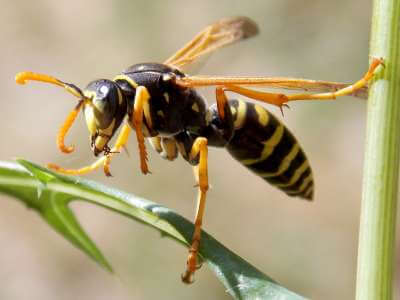
What Do Paper Wasps Look Like?
Paper wasps are commonly mistaken for yellow jackets. They have slender bodies with a thin waist and orange-tipped antennae. They are predominantly black with orange or yellow stripes on the abdomen and are approximately 5/8 to 3/4 of an inch long. Due to the shape of their unique paper-like nest, paper wasps are sometimes called umbrella wasps. These wasps are semi-social insects that live in small colonies of 10 to 50 members.
Have a Wasp Problem?
Get rid of paper wasps in your home or business with our professional wasp control services!
What are the Signs of a Paper Wasp Infestation?
Paper wasps often build nests in residential yards. A clear sign of an infestation is spotting the nest. You will also notice worker wasps flying around the nest and the surrounding area. Yards with numerous sheltered areas are at greater risk of an infestation. Common areas to find wasp nests include lighting fixtures, trees, window frames, porches, playgrounds, and overhangs.
Do Paper Wasps Sting?
Yes, paper wasps can sting. They are mostly likely to sting when their nest is disturbed. Unlike yellow jackets and hornets, they are not aggressive when away from their nests. A paper wasp sting can be very painful, causing a burning sensation and swelling for up to 24 hours.
If you are stung, remove the stinger with a tweezer. Do not squeeze the stinger, as it can inject more venom. Next, ice the area. If you were stung on the arm or leg, keep it elevated. The sting will be painful, so take acetaminophen or ibuprofen to lessen the pain. If difficulty breathing, tightness in the throat, nausea, fast pulse, dizziness, or loss of consciousness occurs, seek medical attention immediately.

Paper Wasp Nest Removal in Milwaukee, WI
If you discover a paper wasp nest on your property, do not try to remove it yourself. Paper wasps are highly protective of their nests and will sting you if provoked! Contact the pest control experts at Advanced Wildlife and Pest Control for safe and effective wasp nest removal. Our wasp exterminators offer reliable, long-lasting solutions to eliminate hornets and wasps from your home or business. Take advantage of our seasonal stinging pest treatments in spring and summer to keep your property pest-free all year round.
